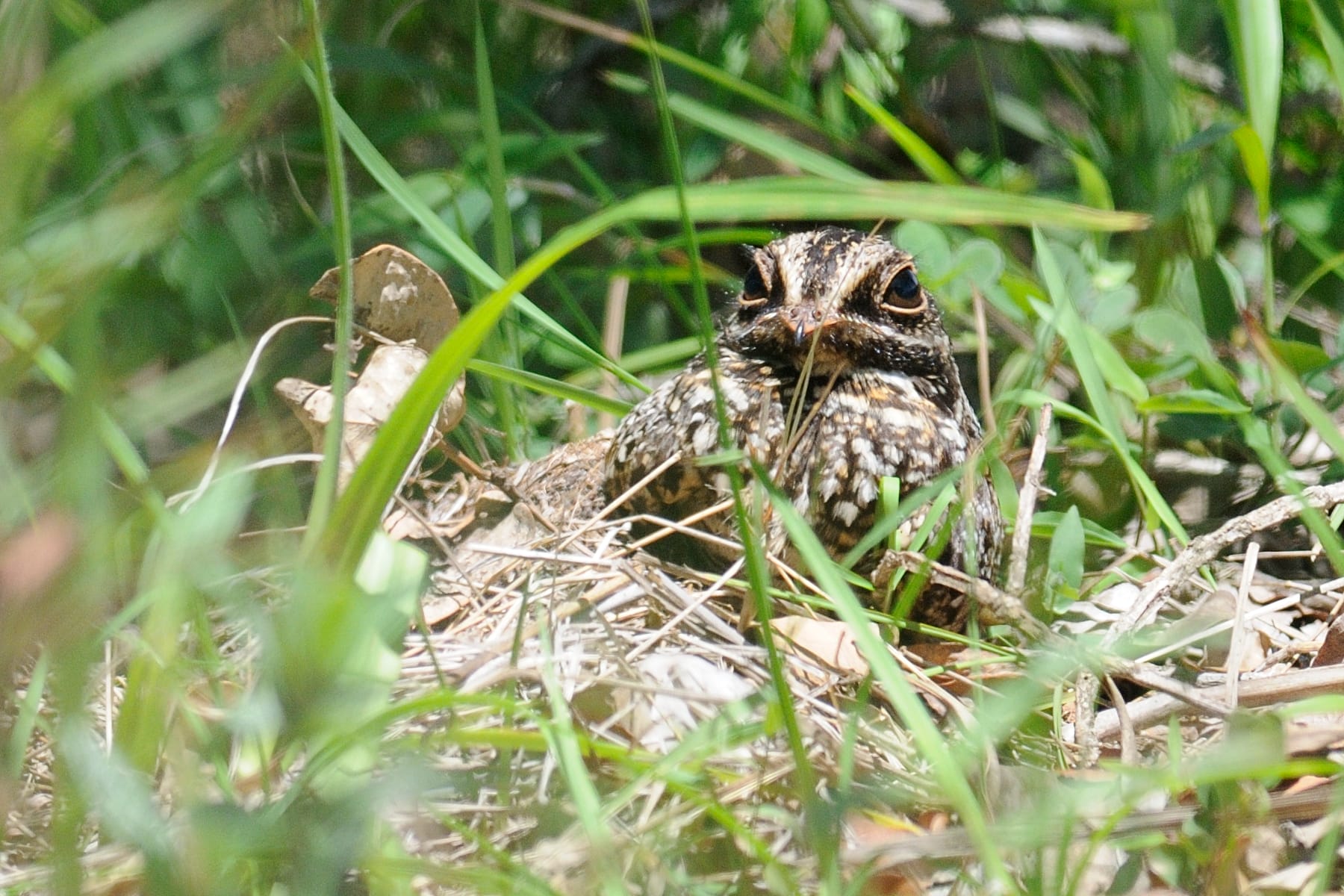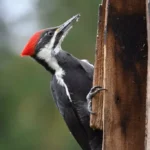Prepare to delve into the captivating world of the Swamp Nightjar, an African bird renowned for its mastery of disguise. This “Whispering Shadow” navigates the night with haunting calls, captivating both bird enthusiasts and scientists alike. Let’s uncover the secrets of this enigmatic creature, exploring its preferred haunts, unique characteristics, and the challenges it faces in a changing world.
The Swamp Nightjar’s Shadowy Realm
Imagine a creature so flawlessly camouflaged that it seems to melt into the shadows—this is the essence of the Swamp Nightjar. Unlike owls seeking refuge in tree hollows, this bird relies almost entirely on its remarkable camouflage. Picture a tapestry woven from browns and greys, mimicking the dappled light filtering through reeds and grasses—that’s the Swamp Nightjar’s cloak of invisibility.
As twilight descends, these feathered phantoms awaken, their keen eyesight, akin to built-in night vision goggles, piercing the darkness. Moths, beetles, and other unsuspecting insects become their airborne buffet, snatched with a swift snap of their beaks.
Courtship among these birds is far from mundane. A male Swamp Nightjar, hoping to woo a mate, takes to the sky, flashing a brilliant white patch hidden beneath his tail feathers—a fleeting but unforgettable spectacle. This aerial dance serves a dual purpose: attracting a potential partner and warning off any rivals lurking nearby.
Where Shadows Dwell: Unmasking the Swamp Nightjar’s Habitat
These secretive birds, with a penchant for warmer weather, make their homes across a vast expanse of Africa, south of the Sahara Desert. Countries like Zambia, Tanzania, Namibia, and South Africa represent their stomping grounds. However, they’re not particularly picky about their addresses. You might find them in a soggy swamp one day and at the edge of a forest the next. They’ve even been known to appear in open grasslands.
The common denominator in these varied locations? An abundance of insects! Swamp Nightjars are nature’s insect control, devouring them as their primary food source. They prefer to nest on the ground, tucked away under leaves or bushes for added privacy.
Despite their name, Swamp Nightjars are surprisingly adaptable. Their camouflage skills are so exceptional that they practically vanish into their surroundings. This adaptability allows them to thrive in diverse environments and effortlessly move between habitats if needed.
Key Insights:
- Range: Across sub-Saharan Africa.
- Preferred Habitats: Wetlands, forest edges, savannas, and even grasslands.
- Essential Needs: A plentiful supply of insects and a secure ground-level nesting site.
- Variable Distribution: They may be present in some areas within their range but absent in others.
- Threats: Habitat loss due to human activities poses a significant risk.
- Conservation Status: Currently considered vulnerable, highlighting the need for conservation efforts.
- Conservation Actions: Protecting their habitats, promoting sustainable land management, and conducting further research are crucial.
Swamp Nightjar Flight Analysis: Soaring Through the Night
Swamp Nightjars are more often heard than seen, their cryptic plumage camouflaging them perfectly against the wetland floor. But don’t let their daytime elusiveness fool you—these birds are masters of the night sky.
As dusk settles and insects fill the air, the Swamp Nightjar transforms into an agile aerial predator, its silent wings slicing through the darkness. They can cover a surprising amount of ground, snatching insects out of the air with remarkable accuracy.
How do they achieve such aerial prowess? Their long, sleek wings are perfectly designed for gliding and making sharp turns, and their lightweight bodies minimize the effort needed for flight. In essence, they were born to be airborne.
Their feathers also play a crucial role in their hunting success. Imagine the colors and patterns of a swamp—browns, blacks, tans—and now picture a bird with feathers that perfectly match these hues, breaking up their outline and rendering them nearly invisible. This is the Swamp Nightjar’s secret weapon. During the day, they hunker down in the reeds and grasses, their camouflage shielding them from predators.
While Swamp Nightjars are not currently facing imminent danger, they still face challenges. Wetlands around the world are disappearing, shrinking the spaces where these fascinating birds can live and find food. Protecting their wetland homes is paramount to their survival, making conservation efforts essential.
Unmasking the Swamp Nightjar: A Closer Look
Spotting a Swamp Nightjar during the day is like finding a needle in a haystack. Their camouflage is so effective that they practically vanish against the backdrop of their wetland homes. But as soon as the sun dips below the horizon, these birds come alive.
Picture this: It’s dusk, and the air buzzes with insects. A Swamp Nightjar, roughly the size of a robin, perches silently on a low branch. Its mottled brown and black feathers blend seamlessly with the surrounding vegetation. Suddenly, it takes flight, its broad tail—adorned with white patches in males and buff patches in females—momentarily flashing in the fading light. It swoops gracefully through the air, snapping up insects with impressive accuracy. This is the Swamp Nightjar in its element—a master of the night.
Swamp Nightjars are not particularly social birds. They usually prefer their own company or that of their mate, except during breeding season. When it comes to nesting, they keep things simple. A simple scrape on the ground, hidden among vegetation, is all they need. Both parents share the responsibility of protecting their eggs and chicks from predators.
Here’s a closer look at some of their key characteristics:
| Feature | Description |
|---|---|
| Size | Small to medium-sized, roughly the size of a robin (20-24 cm or 8-9.5 inches long) |
| Weight | Surprisingly lightweight, weighing in at a mere 60-70 grams (2.1-2.5 ounces) |
| Coloration | Their plumage, a mix of mottled brown and black feathers, is their best camouflage, helping them disappear into their surroundings. Males and females can be distinguished by the pale patches on their tails: white for males and buff for females. |
| Habitat | True to their name, they favor wetlands such as swamps, marshes, and the edges of lakes and rivers. Interestingly, they can also be found in savannas dotted with trees and tall grasses. |
| Diet | They are strict insectivores, meaning their diet consists solely of insects like moths, flies, and beetles. |
| Vocalizations | They’re known for their distinctive “chow” calls, especially at dusk. They might also communicate using clicks and whistles. |
While Swamp Nightjars are relatively widespread, their populations in certain regions, such as South Africa, are considered vulnerable due to habitat loss and degradation. Thankfully, conservation organizations are working tirelessly to protect their wetland homes and learn more about these fascinating creatures to ensure their survival.
Researchers are constantly making new discoveries, so our understanding of these birds is continually evolving. It’s important to remember that we still have much to learn about the secret lives of these nocturnal wonders.
Explore Further:
Delve deeper into the fascinating world of other unique species:
- Discover the beauty of the silene capensis with its delicate pink flowers and delightful fragrance.
- Immerse yourself in the life of the stonefly nymph, an underwater marvel with an incredible ability to survive in challenging environments.
- Jerry McSorley’s Post-Divorce Life: New Beginnings - July 16, 2025
- The Rise and Fall of the New Haven Nighthawks: A Minor League Hockey Legacy - July 16, 2025
- Unlock Jerry McSorley’s Career Highlights: Eye Tax Inc.’s Solar Success - July 16, 2025

















2 thoughts on “Unmasking the Swamp Nightjar: Secrets of Africa’s Whispering Shadow”
Comments are closed.